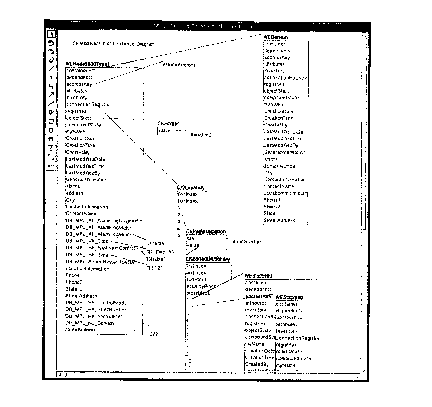Some of the information on this Web page has been provided by external sources. The Government of Canada is not responsible for the accuracy, reliability or currency of the information supplied by external sources. Users wishing to rely upon this information should consult directly with the source of the information. Content provided by external sources is not subject to official languages, privacy and accessibility requirements.
Any discrepancies in the text and image of the Claims and Abstract are due to differing posting times. Text of the Claims and Abstract are posted:
| (12) Patent Application: | (11) CA 2221654 |
|---|---|
| (54) English Title: | KNOWLEDGE MODULE |
| (54) French Title: | MODULE DE CONNAISSANCES |
| Status: | Deemed Abandoned and Beyond the Period of Reinstatement - Pending Response to Notice of Disregarded Communication |
| (51) International Patent Classification (IPC): |
|
|---|---|
| (72) Inventors : |
|
| (73) Owners : |
|
| (71) Applicants : |
|
| (74) Agent: | MARKS & CLERK |
| (74) Associate agent: | |
| (45) Issued: | |
| (22) Filed Date: | 1997-11-20 |
| (41) Open to Public Inspection: | 1999-05-20 |
| Availability of licence: | N/A |
| Dedicated to the Public: | N/A |
| (25) Language of filing: | English |
| Patent Cooperation Treaty (PCT): | No |
|---|
| (30) Application Priority Data: | None |
|---|
A object, known as a Knowledge Module encapsulates all network management
information which is required about a class of network component, including the name of the
class, the object-oriented superclass, attribute descriptions which includes the valid values,
type of the attribute, and translation information, containment rules, communication protocol
information, provisioning rules, inter-object relationship information, intra-object
inter-attribute relationship information, customizable provisioning screens, database storage and
retrieval information.
Note: Claims are shown in the official language in which they were submitted.
Note: Descriptions are shown in the official language in which they were submitted.

2024-08-01:As part of the Next Generation Patents (NGP) transition, the Canadian Patents Database (CPD) now contains a more detailed Event History, which replicates the Event Log of our new back-office solution.
Please note that "Inactive:" events refers to events no longer in use in our new back-office solution.
For a clearer understanding of the status of the application/patent presented on this page, the site Disclaimer , as well as the definitions for Patent , Event History , Maintenance Fee and Payment History should be consulted.
| Description | Date |
|---|---|
| Inactive: IPC expired | 2019-01-01 |
| Inactive: IPC expired | 2018-01-01 |
| Inactive: IPC from MCD | 2006-03-12 |
| Application Not Reinstated by Deadline | 2002-11-20 |
| Time Limit for Reversal Expired | 2002-11-20 |
| Deemed Abandoned - Failure to Respond to Maintenance Fee Notice | 2001-11-20 |
| Inactive: Inventor deleted | 2000-05-24 |
| Inactive: Inventor deleted | 2000-05-24 |
| Inactive: Inventor deleted | 2000-05-24 |
| Inactive: Inventor deleted | 2000-05-24 |
| Inactive: Inventor deleted | 2000-05-24 |
| Inactive: Inventor deleted | 2000-05-24 |
| Inactive: Applicant deleted | 2000-05-24 |
| Inactive: Cover page published | 1999-06-16 |
| Application Published (Open to Public Inspection) | 1999-05-20 |
| Inactive: Correspondence - Formalities | 1998-08-21 |
| Inactive: Single transfer | 1998-08-21 |
| Inactive: IPC assigned | 1998-03-18 |
| Inactive: First IPC assigned | 1998-03-18 |
| Inactive: IPC assigned | 1998-03-18 |
| Classification Modified | 1998-03-18 |
| Inactive: IPC assigned | 1998-03-18 |
| Inactive: Courtesy letter - Evidence | 1998-02-17 |
| Inactive: Filing certificate - No RFE (English) | 1998-02-11 |
| Filing Requirements Determined Compliant | 1998-02-11 |
| Application Received - Regular National | 1998-02-10 |
| Abandonment Date | Reason | Reinstatement Date |
|---|---|---|
| 2001-11-20 |
The last payment was received on 2000-08-03
Note : If the full payment has not been received on or before the date indicated, a further fee may be required which may be one of the following
Please refer to the CIPO Patent Fees web page to see all current fee amounts.
| Fee Type | Anniversary Year | Due Date | Paid Date |
|---|---|---|---|
| Application fee - standard | 1997-11-20 | ||
| Registration of a document | 1998-08-21 | ||
| MF (application, 2nd anniv.) - standard | 02 | 1999-11-22 | 1999-11-04 |
| MF (application, 3rd anniv.) - standard | 03 | 2000-11-20 | 2000-08-03 |
Note: Records showing the ownership history in alphabetical order.
| Current Owners on Record |
|---|
| CROSSKEYS SYSTEMS CORPORATION |
| Past Owners on Record |
|---|
| FRANK SUKHU |
| GWEN MUNN |
| KATHERINE BARRY |
| KEVIN DRIEDGER |
| MICHAEL J. MCCLOSKEY |